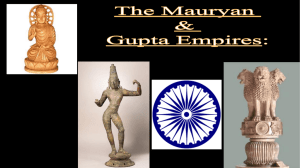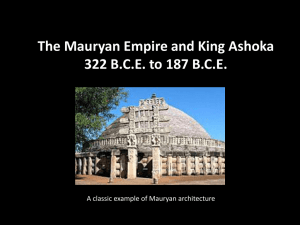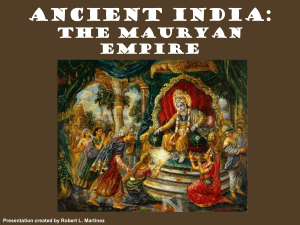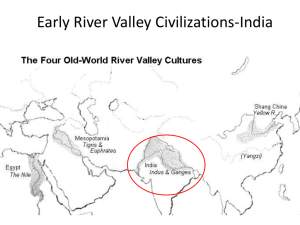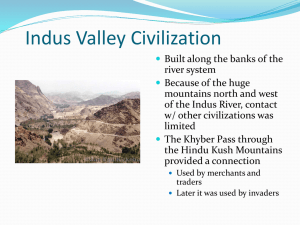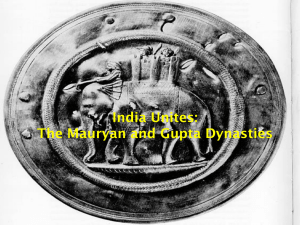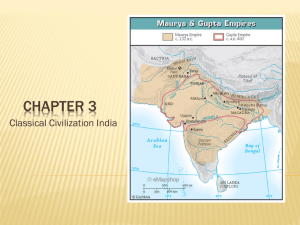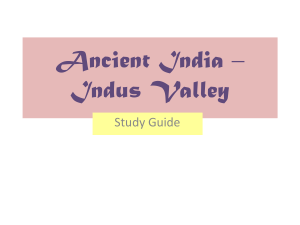India - truth alone triumphs
advertisement
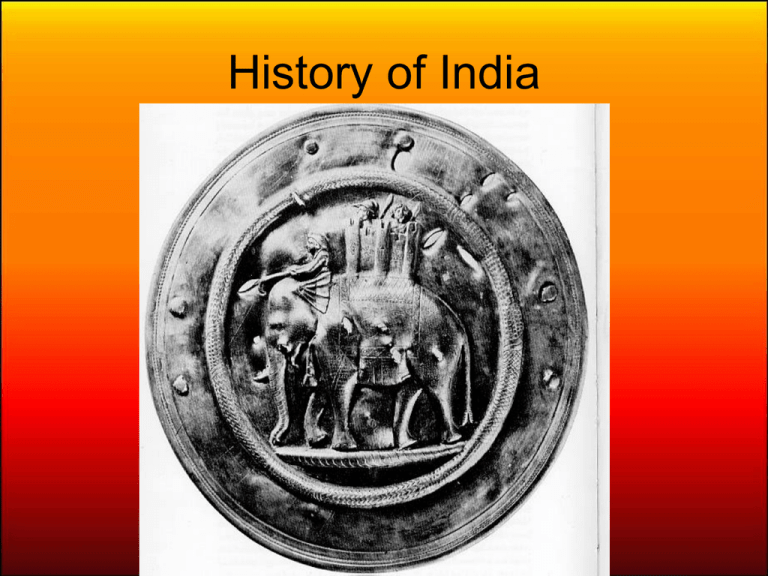
History of India History of India Divided in 10 Periods 1. Indus Valley Civilization: led by the city states of Mohenjo-Daro and Harappa 2. Aryans (2500BC – 322BC) Hinduism and regional kingdoms develop 3. The Mauryan Empire (322BC – 188BC) • Spread of Buddhism and the first Indian Empire started by Chandragupta 4. Gupta Period (320AD – 480AD) • Golden Age of India 5. Muslim Invasions (1175AD – 1300AD) • Muslims Turks from Afghanistan invade and begin to re-unite India into small kingdoms Indian Civilization (cont) 6. Delhi Sultanate is the largest of these kingdoms ruled by Muslim Turks 7. Mughals – most powerful of Indian dynasties controlled most of today’s India, Pakistan and Bangladesh 8. Europeans begin to Rule (1500AD – 1850AD) • Portuguese, French, Dutch, and English centers of rule dominated by Corporations not countries 9. English Imperialism – ruled as an English colony for almost 100 years 10. Independence and Democratic India – Muslim and Hindu political groups push for and eventually gain independence from European Imperialism. Today India is one of the most important, powerful countries in the world and is rapidly growing in influence Indus Valley Civilizations Indus River Valley Civilization 3500-1500 BCE • Two City States and many smaller villages • Harappa • Mohenjo-daro Both had – centrally planned cities – city walls – Public buildings – grainaries – toilets, wells, drainage system – brick lined sewers in the streets Politics • City states • Governed by Priest Kings • The Indus Valley script has never been translated • so we know very little about their lifestyle or belief system beyond what architecture tells us Indus Valley Civilization Economy • • • • • Agricultural cotton and food crops Industry = textiles Irrigation Canals Craft workers made beautiful clay figurines • Made jewels from gold, silver and copper. Social/Religion • Polytheist nature gods; fertility goddess important • Priests/kings in villages had high importance • Some merchants but mostly farmers End of the Indus Valley • Repeated floods caused the course of the Indus River to shift away from the cities • The Indus Valley script has never been translated so we know very little about their lifestyle or belief system beyond what architecture tells us • New cultural group called Aryans migrate/invade and merge with the Indus Valley peoples Aryan Migration pastoral depended on their cattle. warriors horse-drawn chariots. Sanskrit writing The Vedas 1200 BCE-600 BCE. written in SANSKRIT. Hindu core of beliefs: Rig Veda oldest work. hymns and poems. religious prayers. magical spells. lists of the gods and goddesses. • India’s greatest epic poem: Mahabharata and the Ramayana (about important battles) • Upanishads: epic poems that are mystical and religious. Varna (Social Hierarchy) Brahmins Kshatriyas Vaishyas Shudras Pariahs [Harijan] Untouchables The Caste System WHO IS… Brahmins Kshatriyas The mouth? The arms? Vaishyas The legs? The feet? What is a JATI? Shudras The Vedic Age The foundations for Hinduism were established! India Unites: The Mauryan and Gupta Dynasties Aryan Age ends with Invasion of Darius and Alexander India begins to Unite c. 400-300BCE Persia first united NW India under Cyrus and Darius c. 330 Alexander the Great conquered Persia Greek empire failed when Alexander died Now a native Indian Empire would begin. The Mauryan Empire 321-180 BCE Politics • Founded by Chandragupta Maurya ( 324 to 301 B.C.) • Increased centralized govt control over regional kingdoms • large army of 700,000 • secret police to watch for treason 301 BCE gave up his throne to & became a Jain monk (extreme Buddhism) Ashoka Maurya Ashoka 268-232 BC Most important ruler in ancient India Brutal military commander who extended the Empire throughout S. and E. India Battle of Kalinga - 260 BC 100,000 Kalingans died 150,000 Kalingans driven from their home More died from disease & starvation in the aftermath of the destruction brought on by the war “What have I done?” Ashoka and many Indian leaders converted to Buddhism after this battle and became pacifists He spent the rest of his life encouraging non-violence, moderation and Buddhist principles to India Asoka’s Buddhist Rock and Pillar Edicts spread Buddhist principles scattered in more than 30 places in India, Nepal,Pakistan, & Afghanistan. Each pillar is 40’-50’ high. helped bring order and unity to India Trade/Economy Agricultural economy •New canals and irrigation systems for trade and agriculture. •renovated major roads throughout India. •built towns for spinning & weaving textiles •uniform system of currency, weights and measures •Created provinces ruled by governors for tax assessments and law enforcement •Taxes rose over time to build Ashoka’s projects which led to Empire’s fall at Ashoka’s death •Increased trade by uniting India •India traded silk, cotton, and spices to Mesopotamia, China, Egypt and Rome Silver punch mark coin Indian Agriculture State farms operated and cultivated by slaves. Grew Rice, Pepper, Wheat, Barley, Mustard, Sugar Cane, Medicinal Roots Religion Buddhism grows built thousands of Stupas for Buddhist followers. built Buddhist schools and universities the unnecessary eating of animals was abolished. Wildlife became protected including the first national parks in the world promoted vegetarianism and built animal hospitals. Ashoka’s empire died out slowly after he died The Sanchi Stupa (Buddhist temple) by Ashoka Similarities between Buddhist Stupas and Pagotas Buddhism architecture spread from India when Buddhism spread over the next 1000 years The Mauryan Empire at its Height Social • The Caste System limited social opportunities & determined who people could marry • Families are patriarchal—headed by the eldest male • Laws limited women’s life and abilities Sati was sometimes practiced “Even a man in the grip of rage will not be harsh to a woman, remembering that on her depends the joy of love, happiness and virtue” Mahabharata epic Indian Population •50 million people during Mauryan Empire The Arts transition from wood to stone in their architecture and art Ashoka's Pillars Indian Stupa After the Mauryans: Regional Rule and the Rise of Jainism and Buddhism Regional Kingdoms and local rule 185 BCE to CE 300 Northern India Invading HUNS built new small regional kingdoms Hindu Kush civilizations Most powerful regional kingdoms for trade across the region and along the Silk Road Jainism grew in influence during this time of confusion since the leaders pushing Hindu and Buddhism were weakened Jainism – like Hindu and Buddhism Believe in karma, dharma and Moksha expected to follow five principles of living: Ahimsa: "non violence in all parts of a person -- mental, verbal and physical." Satya: speaking truth; avoiding falsehood Asteya: to not steal from others Brahma-charya: (soul conduct); remaining sexually monogamous to one's spouse only Aparigraha: detach from people, places and material things. Avoiding the collection of excessive material possessions, abstaining from overindulgence, restricting one's needs,
